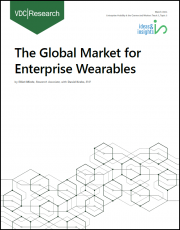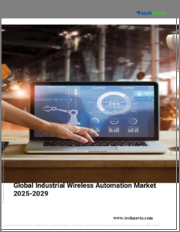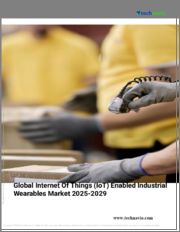
|
시장보고서
상품코드
1722671
기업용 웨어러블 시장 보고서 : 제품 유형, 기술, 최종사용자, 지역별(2025-2033년)Enterprise Wearables Market Report by Product Type, Technology (Bluetooth, Internet of Things ), End User, and Region 2025-2033 |
||||||
세계 기업용 웨어러블 시장 규모는 2024년 88억 달러에 달했습니다. 향후 IMARC Group은 2033년에는 1,341억 달러에 달하고, 2025-2033년 33.58%의 연평균 성장률(CAGR)을 보일 것으로 전망하고 있습니다.
현재 직원의 안전은 직장에서의 부상, 질병, 사망을 예방하기 위한 최우선 과제로 떠오르고 있습니다. 이에 따라 전 세계적으로 통신, 인포테인먼트, 헬스케어, 정보기술(IT), 자동차, 운송 분야에서 웨어러블 기기의 사용이 증가하고 있습니다. 웨어러블 기기는 고용주에게 직원의 생산성과 성과를 향상시키는 데 도움이 되는 실시간 통찰력을 제공합니다. 또한, 웰니스 프로그램의 일환으로 직원의 건강 및 피트니스 관련 정보를 추적할 수 있습니다.
기업용 웨어러블 시장 동향 :
센서 기술의 발전은 시장 성장을 가속하는 중요한 요소 중 하나입니다. 또한, 기업용 웨어러블에는 피트니스 트래커, 임베디드 웨어러블, 스마트 링, 안경, 의복이 포함되며, 근로자의 심박수, 혈압, 체온에 대한 정보를 제공합니다. 또한 외골격, 웨어러블 로봇, 무거운 물건을 들어 올릴 때 자세를 제어하는 패치 등도 포함됩니다. 이 외에도 기업용 웨어러블에서는 핸드프리 마이크가 내장된 헤드셋 등이 편리하며, 작업 중 방해받지 않고 작업자 간 커뮤니케이션을 용이하게 해줍니다. 이와는 별도로 가상현실(VR) 및 증강현실(AR) 헬멧을 사용하면 복잡한 작업을 수행하기 전에 작업자를 쉽게 교육할 수 있어 부상 가능성을 줄일 수 있습니다. 또한, 기업용 웨어러블은 작업 현장의 온도, 기압, 방사선 수치에 대한 데이터를 제공하므로 기업은 비상사태를 예방하고 적시에 작업자를 대피시킬 수 있습니다. 이러한 이점이 기업용 웨어러블의 세계 매출을 견인하고 있습니다. 또한, 즉각적인 도움이 필요한 환자의 푸시 알림을 받기 위해 의료 서비스 제공업체가 이러한 웨어러블을 점점 더 많이 사용하는 것은 향후 몇 년 동안 시장에 긍정적인 영향을 미칠 것으로 예측됩니다.
본 보고서에서 다룬 주요 질문
- 세계 기업용 웨어러블 시장은 지금까지 어떻게 성장해왔고, 앞으로 어떻게 변화할 것인가?
- 코로나19가 세계 기업용 웨어러블 시장에 미치는 영향은?
- 주요 지역 시장은?
- 제품 유형별 시장 분석은?
- 기술별 시장 분석은?
- 최종사용자별 시장 분석은?
- 산업 가치사슬의 다양한 단계는?
- 업계의 주요 촉진요인과 과제는?
- 세계 기업용 웨어러블 시장의 구조와 주요 기업은?
- 업계 내 경쟁은 어느 정도인가?
목차
제1장 서문
제2장 조사 범위와 조사 방법
- 조사 목적
- 이해관계자
- 데이터 소스
- 1차 정보
- 2차 정보
- 시장 추정
- 보텀업 접근
- 톱다운 접근
- 조사 방법
제3장 주요 요약
제4장 서론
- 개요
- 주요 업계 동향
제5장 세계의 기업용 웨어러블 시장
- 시장 개요
- 시장 실적
- COVID-19의 영향
- 시장 예측
제6장 시장 분석 : 제품 유형별
- 리스트웨어
- 안경류
- 헤드웨어
- 기타
제7장 시장 분석 : 기술별
- Bluetooth
- 사물인터넷(IoT)
제8장 시장 분석 : 최종사용자별
- 제조
- 헬스케어
- 소매
- 항공우주 및 방위
- IT 및 통신
- 기타
제9장 시장 분석 : 지역별
- 북미
- 미국
- 캐나다
- 아시아태평양
- 중국
- 일본
- 인도
- 한국
- 호주
- 인도네시아
- 기타
- 유럽
- 독일
- 프랑스
- 영국
- 이탈리아
- 스페인
- 러시아
- 기타
- 라틴아메리카
- 브라질
- 멕시코
- 기타
- 중동 및 아프리카
- 시장 내역 : 국가별
제10장 SWOT 분석
- 개요
- 강점
- 약점
- 기회
- 위협
제11장 밸류체인 분석
제12장 Porter의 Five Forces 분석
- 개요
- 바이어의 교섭력
- 공급 기업의 교섭력
- 경쟁 정도
- 신규 진출업체의 위협
- 대체품의 위협
제13장 가격 분석
제14장 경쟁 구도
- 시장 구조
- 주요 기업
- 주요 기업 개요
- Adidas AG
- Apple Inc.
- AT&T Inc.
- EnOcean GmbH
- Eurotech S.p.A.
- Fossil Group Inc.
- Google LLC
- Samsung Electronics Co. Ltd.
- Seiko Epson Corporation
- Sony Corporation
- Texas Instruments Incorporated
- Xiaomi Inc.
The global enterprise wearables market size reached USD 8.8 Billion in 2024. Looking forward, IMARC Group expects the market to reach USD 134.1 Billion by 2033, exhibiting a growth rate (CAGR) of 33.58% during 2025-2033.
Ensuring the safety of employees currently remains a top priority to prevent workplace injuries, illnesses, and deaths. As a result, there is a rise in the usage of wearable devices in telecommunications, infotainment, healthcare, information technology (IT), automotive, and transportation sectors across the globe. Wearable devices provide employers with real-time insights that help improve the productivity and performance of employees. They also track information related to the health and fitness of employees as a part of their wellness program.
Enterprise Wearables Market Trends:
Rising advancements in sensor technology represent one of the key factors propelling the growth of the market. Moreover, enterprise wearables include fitness trackers, implantable wearables, smart rings, glasses, and clothing, which offer information about heart rate, blood pressure, and the body temperature of workers. They also comprise exoskeletons, wearable robots, and patches to control the position of the body while lifting heavy objects. Besides this, enterprise wearables, such as headsets with embedded hand-free microphones, are convenient and ease communication between workers without causing a distraction during work. Apart from this, the usage of virtual reality (VR) and augmented reality (AR) helmets facilitate the training of workers on complicated operations before performing them, thereby reducing the likelihood of injury. In addition, enterprise wearables provide data about the temperature, atmospheric pressure, and level of radiation at the worksite, which enables enterprises to prevent emergencies and organize the evacuation of workers timely. These advantages are driving the sales of enterprise wearables worldwide. Furthermore, the increasing utilization of these wearables by healthcare providers to receive push notifications from patients in need of immediate assistance is projected to positively influence the market in the coming years.
Key Market Segmentation:
Breakup by Product Type:
- Wrist Wear
- Eye Wear
- Head Wear
- Others
Breakup by Technology:
- Bluetooth
- Internet of Things (IoT)
Breakup by End User:
- Manufacturing
- Healthcare
- Retail
- Aerospace and Defense
- IT and Telecom
- Others
Breakup by Region:
- North America
- United States
- Canada
- Asia-Pacific
- China
- Japan
- India
- South Korea
- Australia
- Indonesia
- Others
- Europe
- Germany
- France
- United Kingdom
- Italy
- Spain
- Russia
- Others
- Latin America
- Brazil
- Mexico
- Others
- Middle East and Africa
Competitive Landscape:
The competitive landscape of the industry has also been examined along with the profiles of the key players being Adidas AG, Apple Inc., AT&T Inc., EnOcean GmbH, Eurotech S.p.A., Fossil Group Inc., Google LLC, Samsung Electronics Co. Ltd., Seiko Epson Corporation, Sony Corporation, Texas Instruments Incorporated and Xiaomi Inc.
Key Questions Answered in This Report:
- How has the global enterprise wearables market performed so far and how will it perform in the coming years?
- What has been the impact of COVID-19 on the global enterprise wearables market?
- What are the key regional markets?
- What is the breakup of the market based on the product type?
- What is the breakup of the market based on the technology?
- What is the breakup of the market based on the end user?
- What are the various stages in the value chain of the industry?
- What are the key driving factors and challenges in the industry?
- What is the structure of the global enterprise wearables market and who are the key players?
- What is the degree of competition in the industry?
Table of Contents
1 Preface
2 Scope and Methodology
- 2.1 Objectives of the Study
- 2.2 Stakeholders
- 2.3 Data Sources
- 2.3.1 Primary Sources
- 2.3.2 Secondary Sources
- 2.4 Market Estimation
- 2.4.1 Bottom-Up Approach
- 2.4.2 Top-Down Approach
- 2.5 Forecasting Methodology
3 Executive Summary
4 Introduction
- 4.1 Overview
- 4.2 Key Industry Trends
5 Global Enterprise Wearables Market
- 5.1 Market Overview
- 5.2 Market Performance
- 5.3 Impact of COVID-19
- 5.4 Market Forecast
6 Market Breakup by Product Type
- 6.1 Wrist Wear
- 6.1.1 Market Trends
- 6.1.2 Market Forecast
- 6.2 Eye Wear
- 6.2.1 Market Trends
- 6.2.2 Market Forecast
- 6.3 Head Wear
- 6.3.1 Market Trends
- 6.3.2 Market Forecast
- 6.4 Others
- 6.4.1 Market Trends
- 6.4.2 Market Forecast
7 Market Breakup by Technology
- 7.1 Bluetooth
- 7.1.1 Market Trends
- 7.1.2 Market Forecast
- 7.2 Internet of Things (IoT)
- 7.2.1 Market Trends
- 7.2.2 Market Forecast
8 Market Breakup by End User
- 8.1 Manufacturing
- 8.1.1 Market Trends
- 8.1.2 Market Forecast
- 8.2 Healthcare
- 8.2.1 Market Trends
- 8.2.2 Market Forecast
- 8.3 Retail
- 8.3.1 Market Trends
- 8.3.2 Market Forecast
- 8.4 Aerospace and Defense
- 8.4.1 Market Trends
- 8.4.2 Market Forecast
- 8.5 IT and Telecom
- 8.5.1 Market Trends
- 8.5.2 Market Forecast
- 8.6 Others
- 8.6.1 Market Trends
- 8.6.2 Market Forecast
9 Market Breakup by Region
- 9.1 North America
- 9.1.1 United States
- 9.1.1.1 Market Trends
- 9.1.1.2 Market Forecast
- 9.1.2 Canada
- 9.1.2.1 Market Trends
- 9.1.2.2 Market Forecast
- 9.1.1 United States
- 9.2 Asia-Pacific
- 9.2.1 China
- 9.2.1.1 Market Trends
- 9.2.1.2 Market Forecast
- 9.2.2 Japan
- 9.2.2.1 Market Trends
- 9.2.2.2 Market Forecast
- 9.2.3 India
- 9.2.3.1 Market Trends
- 9.2.3.2 Market Forecast
- 9.2.4 South Korea
- 9.2.4.1 Market Trends
- 9.2.4.2 Market Forecast
- 9.2.5 Australia
- 9.2.5.1 Market Trends
- 9.2.5.2 Market Forecast
- 9.2.6 Indonesia
- 9.2.6.1 Market Trends
- 9.2.6.2 Market Forecast
- 9.2.7 Others
- 9.2.7.1 Market Trends
- 9.2.7.2 Market Forecast
- 9.2.1 China
- 9.3 Europe
- 9.3.1 Germany
- 9.3.1.1 Market Trends
- 9.3.1.2 Market Forecast
- 9.3.2 France
- 9.3.2.1 Market Trends
- 9.3.2.2 Market Forecast
- 9.3.3 United Kingdom
- 9.3.3.1 Market Trends
- 9.3.3.2 Market Forecast
- 9.3.4 Italy
- 9.3.4.1 Market Trends
- 9.3.4.2 Market Forecast
- 9.3.5 Spain
- 9.3.5.1 Market Trends
- 9.3.5.2 Market Forecast
- 9.3.6 Russia
- 9.3.6.1 Market Trends
- 9.3.6.2 Market Forecast
- 9.3.7 Others
- 9.3.7.1 Market Trends
- 9.3.7.2 Market Forecast
- 9.3.1 Germany
- 9.4 Latin America
- 9.4.1 Brazil
- 9.4.1.1 Market Trends
- 9.4.1.2 Market Forecast
- 9.4.2 Mexico
- 9.4.2.1 Market Trends
- 9.4.2.2 Market Forecast
- 9.4.3 Others
- 9.4.3.1 Market Trends
- 9.4.3.2 Market Forecast
- 9.4.1 Brazil
- 9.5 Middle East and Africa
- 9.5.1 Market Trends
- 9.5.2 Market Breakup by Country
- 9.5.3 Market Forecast
10 SWOT Analysis
- 10.1 Overview
- 10.2 Strengths
- 10.3 Weaknesses
- 10.4 Opportunities
- 10.5 Threats
11 Value Chain Analysis
12 Porters Five Forces Analysis
- 12.1 Overview
- 12.2 Bargaining Power of Buyers
- 12.3 Bargaining Power of Suppliers
- 12.4 Degree of Competition
- 12.5 Threat of New Entrants
- 12.6 Threat of Substitutes
13 Price Analysis
14 Competitive Landscape
- 14.1 Market Structure
- 14.2 Key Players
- 14.3 Profiles of Key Players
- 14.3.1 Adidas AG
- 14.3.1.1 Company Overview
- 14.3.1.2 Product Portfolio
- 14.3.1.3 Financials
- 14.3.1.4 SWOT Analysis
- 14.3.2 Apple Inc.
- 14.3.2.1 Company Overview
- 14.3.2.2 Product Portfolio
- 14.3.2.3 Financials
- 14.3.2.4 SWOT Analysis
- 14.3.3 AT&T Inc.
- 14.3.3.1 Company Overview
- 14.3.3.2 Product Portfolio
- 14.3.3.3 Financials
- 14.3.3.4 SWOT Analysis
- 14.3.4 EnOcean GmbH
- 14.3.4.1 Company Overview
- 14.3.4.2 Product Portfolio
- 14.3.5 Eurotech S.p.A.
- 14.3.5.1 Company Overview
- 14.3.5.2 Product Portfolio
- 14.3.5.3 Financials
- 14.3.6 Fossil Group Inc.
- 14.3.6.1 Company Overview
- 14.3.6.2 Product Portfolio
- 14.3.7 Google LLC
- 14.3.7.1 Company Overview
- 14.3.7.2 Product Portfolio
- 14.3.7.3 SWOT Analysis
- 14.3.8 Samsung Electronics Co. Ltd.
- 14.3.8.1 Company Overview
- 14.3.8.2 Product Portfolio
- 14.3.8.3 Financials
- 14.3.8.4 SWOT Analysis
- 14.3.9 Seiko Epson Corporation
- 14.3.9.1 Company Overview
- 14.3.9.2 Product Portfolio
- 14.3.9.3 Financials
- 14.3.9.4 SWOT Analysis
- 14.3.10 Sony Corporation
- 14.3.10.1 Company Overview
- 14.3.10.2 Product Portfolio
- 14.3.10.3 Financials
- 14.3.10.4 SWOT Analysis
- 14.3.11 Texas Instruments Incorporated
- 14.3.11.1 Company Overview
- 14.3.11.2 Product Portfolio
- 14.3.11.3 Financials
- 14.3.11.4 SWOT Analysis
- 14.3.12 Xiaomi Inc.
- 14.3.12.1 Company Overview
- 14.3.12.2 Product Portfolio
- 14.3.12.3 Financials
- 14.3.1 Adidas AG


















